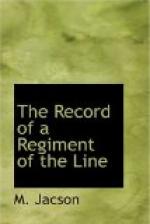[Illustration: The Railway Bridge, with Caesar’s Camp in Distance, Ladysmith]
An hour later the attack on Caesar’s Camp developed. The Manchesters were prepared for them, and one company Gordon Highlanders was sent to reinforce. The Boers, unable to advance against the front crest of Caesar’s Camp, attempted to turn the flank of the Manchesters along the northern slopes. This attempt was foiled by the advance of the one company Gordon Highlanders, assisted by the 53rd Battery which had come into action on the plain below. The Rifle Brigade reinforced Caesar’s Camp at about 7 a.m., and two more companies of the Gordons were sent there at about 2 p.m. By 10 a.m. the Boers had been pushed back off Caesar’s Camp, and Wagon Hill was reported nearly clear.
Wagon Hill was further reinforced by the 18th Hussars at 10 a.m.
At 1 p.m. the Boers, who had always hung on to their crest line, again attempted to rush Wagon Hill point, and though they gained a temporary advantage failed to establish themselves.
Sir George White ordered that the hill should be cleared of Boers at all costs before nightfall, and he sent the 5th Lancers and 19th Hussars to support the troops already at Wagon Hill, and at the same time three companies of the Devons were ordered to proceed there with all dispatch.
At 10 a.m. the three companies of the Devons, which were in camp, commanded respectively by Captain W.B. Lafone, Lieutenant Masterson with Lieutenant Walker, and Lieutenant Field, the whole commanded by Lieutenant-Colonel Park, had been ordered to proceed to the camp near Iron Bridge vacated that morning by the Gordon Highlanders, to be ready as a reserve if wanted.
At about 3.30 p.m. these three companies received orders to proceed at once to Wagon Hill to reinforce Colonel Ian Hamilton’s command and to push on, as help was urgently required. The Adjutant, Captain H.S.L. Ravenshaw, was sent back to camp to order rations and water to be sent out. Wagon Hill was reached at 4.45 p.m., and it was then ascertained that the 5th Lancers and 19th Hussars had already been merged into the firing line, and that a party of forty or fifty Boers were still in possession of the hill some 100 yards in front of the ridge held by the Imperial Light Horse, and directly in front of where the three companies were then halted under cover, that these Boers had been holding on all day there and inflicting great loss, and that our troops had been unable to dislodge them. Colonel Park was asked if he could turn them out by rushing them with the bayonet. He answered, “We will try.” After the three companies had been formed up in column with bayonets fixed and magazines charged, Colonel Park gave the order to advance at fifty paces interval in quick time, and when the top of the ridge was reached to charge the position occupied by the Boers.
The charge took place in a blinding hail-storm, a time well chosen, as the hail was beating into the faces of the Boers. The men, before reaching the place where they formed up for the charge, were wet through, and had put on their warm coats which they had carried strapped on to their belts.




